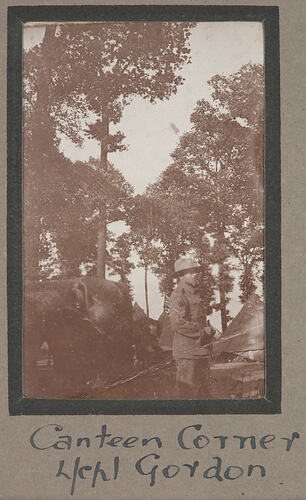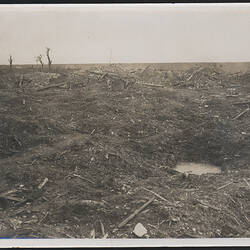Summary
Photograph which possibly depicts Australian soldier and Victoria Cross recipient, Bernard Sidney Gordon. Gordon is recorded as being in Belgium at a similar time as the 13th Field Ambulance of which John Lord was a part of, but it cannot be ascertained if the man in the photograph is actually Gordon due to the unknown date of the photograph.
Lance Corporal Gordon, at 25 years of age, enlisted in the 41st Battalion of the AIF in September 1915 and was deployed to France in May 1916. Gordon was considered a courageous private and showed great initiative but his behaviour out of battle was not always that of a model soldier (as his service records would indicate). He was first wounded in France in October 1917 and after his recovery his actions in August 1918 earned him the Military Medal and a short time later, the Victoria Cross. Gordon was awarded the prestigious Victoria Cross for his assault on an enemy machine gun post where he captured 29 prisoners, two machine-guns and later cleared a number of trenches, captured 63 enemy soldiers and six more machine-guns. It was later stated he displayed a wonderful example of fearless initiative. Gordon returned to Australia in 1919 and lived the remainder of his life as a dairy farmer in Queensland.
It is one of 95 black and white, and, sepia toned photographs taken in France during World War I, attached to a photograph album. The album includes a few photographs of enemy prisoners, the war cemetery at Warloy, a wrecked German ambulance and images of the local French people.
Most photographs are of Albert and surrounds so it would seem probable that most were taken during and after the Battle of the Somme (1916). In addition there are also photographs dated 1917. The photographs were taken by Private John Edward Lord, 13th Field Ambulance, and brought back to Australia by him and compiled in an album at the end of the First World War.
The album is one of many souvenirs brought back to Australia after World War I by Lord, and is part of a larger collection of photograph albums, images, documents and World War I memorabilia donated by Lord to Museum Victoria.
Description of Content
The image features a standing soldier in uniform, identified by the caption as Lance Corporal Gordon. To the left of the soldier is an unsaddled horse. In the background a group of tents are erected. The tents are positioned amongst a group of tall, thick trees.
Physical Description
Monochrome photograph, mounted in a small, grey photograph album.
Significance
This album appears to have been prepared to 'showcase' the war experiences of John Lord and the photographs associated with these. The album has been very carefully prepared and the quality of the photographs is generally good, in comparison to the album ST40491, also compiled by John Lord, which has a number of photographs which are of poor quality, many photographs removed and written in (mostly) illegible pencil. This suggests this album was most probably compiled after the war, with photographs probably gathered from other photograph albums of Lord's.
The subjects of the photographs are of trenches (both German and Allies), horses, camps, farms, graves and cemeteries, civilians, soldiers, churches and other buildings. Many of the photographs were taken around the town of Albert and are dated 1916 and 1917. From this information we can tell that Lord was involved with the Battle of the Somme when these photographs were taken.
The Battle of the Somme was fought from north of the Somme river between the towns of Albert and Arras. The Battle began on the 1 July and was called off on the 18 November 1916. The Battle of the Somme is famous for the loss of 58,000 British troops (one third of them killed) on the first day of the battle, 1 July 1916, which to this day remains a one-day record.
More Information
-
Collection Names
-
Collecting Areas
-
Acquisition Information
Donation from J. Lord, 1986
-
Place & Date Depicted
-
Photographer
Sergeant John Lord, France, 1916-1917
Image may have been taken by Lord or collected by him for use in this album. -
Person Depicted
-
Individuals Identified
L/cpl Gordon
-
Format
Photograph, Monochrome
-
Inscriptions
Handwritten in ink on matt directly below photograph: 'Canteen Corner / L/cpl Gordon'
-
Classification
-
Category
-
Discipline
-
Type of item
-
Image Dimensions - Photograph
60 mm (Width), 45 mm (Height)
-
Image Dimensions - Photograph album page
195 mm (Width), 145 mm (Height)
-
Keywords
Australian Army, Militaria: Australian, Military Memorabilia, Souvenirs, Wars & Conflicts, World War I, 1914-1918


